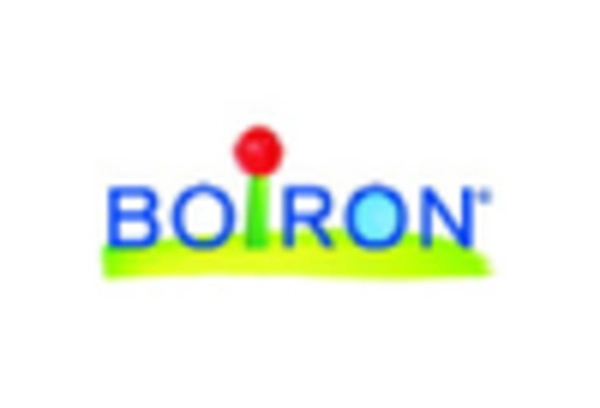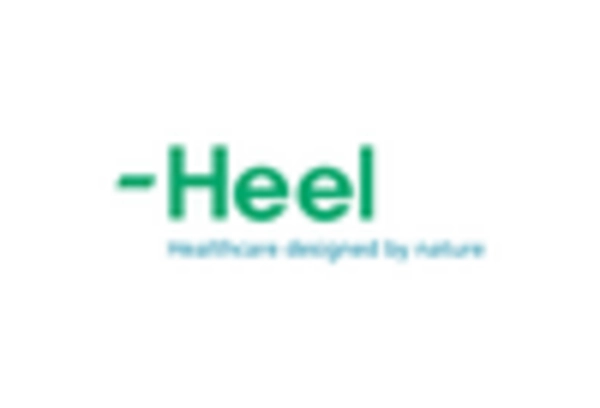The homeopathy market in China is characterized by a competitive landscape that is increasingly dynamic, driven by a growing consumer interest in alternative medicine and natural remedies. Key players such as Boiron (FR), Schwabe (DE), and Heel (DE) are strategically positioned to leverage this trend. Boiron (FR), known for its extensive range of homeopathic products, appears to focus on innovation and product diversification, which may enhance its market share. Schwabe (DE), with its strong emphasis on research and development, seems to prioritize the introduction of new formulations, thereby reinforcing its competitive edge. Meanwhile, Heel (DE) is likely concentrating on expanding its distribution channels, which could facilitate greater market penetration and accessibility for consumers.
The business tactics employed by these companies reflect a nuanced understanding of the market's structure, which is moderately fragmented. Localizing manufacturing and optimizing supply chains are common strategies that these firms adopt to enhance operational efficiency and reduce costs. The collective influence of these key players shapes a competitive environment where agility and responsiveness to consumer preferences are paramount.
In October 2025, Boiron (FR) announced a strategic partnership with a local Chinese herbal medicine company to develop hybrid products that combine homeopathy with traditional Chinese medicine. This collaboration is significant as it not only broadens Boiron's product offerings but also aligns with the cultural preferences of Chinese consumers, potentially increasing market acceptance and sales.
In September 2025, Schwabe (DE) launched a new digital platform aimed at educating consumers about homeopathy and its benefits. This initiative is crucial as it reflects a growing trend towards digitalization in the healthcare sector, allowing Schwabe to engage directly with consumers and enhance brand loyalty. The platform may also serve as a valuable resource for healthcare professionals, thereby expanding Schwabe's influence in the market.
In August 2025, Heel (DE) expanded its manufacturing capabilities in China by investing in a new facility designed to produce homeopathic remedies tailored to local needs. This move is indicative of Heel's commitment to localizing its operations, which could lead to improved supply chain reliability and responsiveness to market demands. Such investments are likely to strengthen Heel's competitive position in the region.
As of November 2025, current trends in the homeopathy market include a pronounced shift towards digitalization, sustainability, and the integration of artificial intelligence in product development and consumer engagement. Strategic alliances are increasingly shaping the competitive landscape, enabling companies to pool resources and expertise. Looking ahead, it appears that competitive differentiation will evolve from traditional price-based competition to a focus on innovation, technological advancements, and the reliability of supply chains. This shift may redefine how companies position themselves in the market, emphasizing the importance of adaptability and consumer-centric strategies.

















Leave a Comment